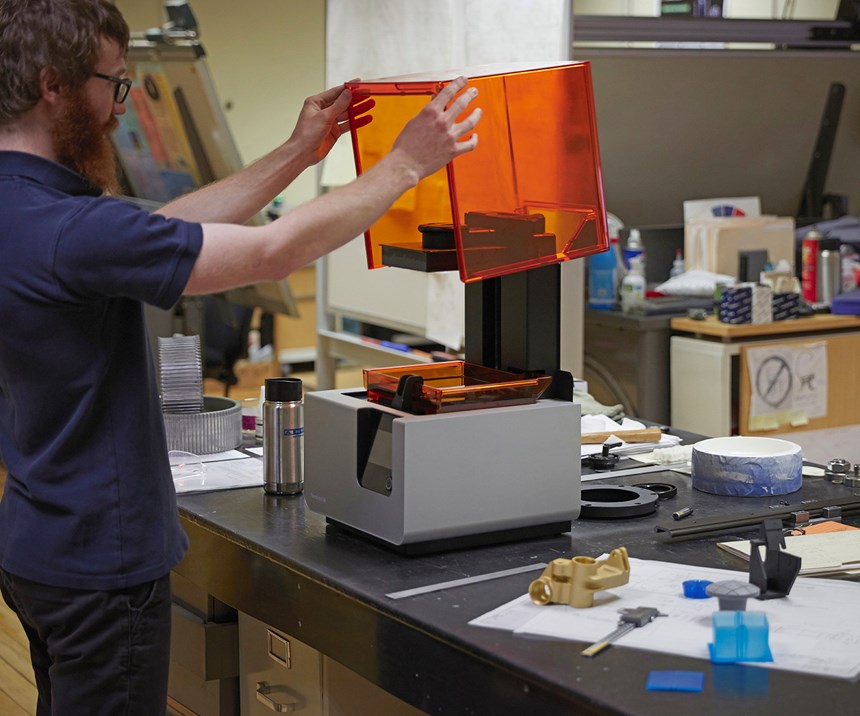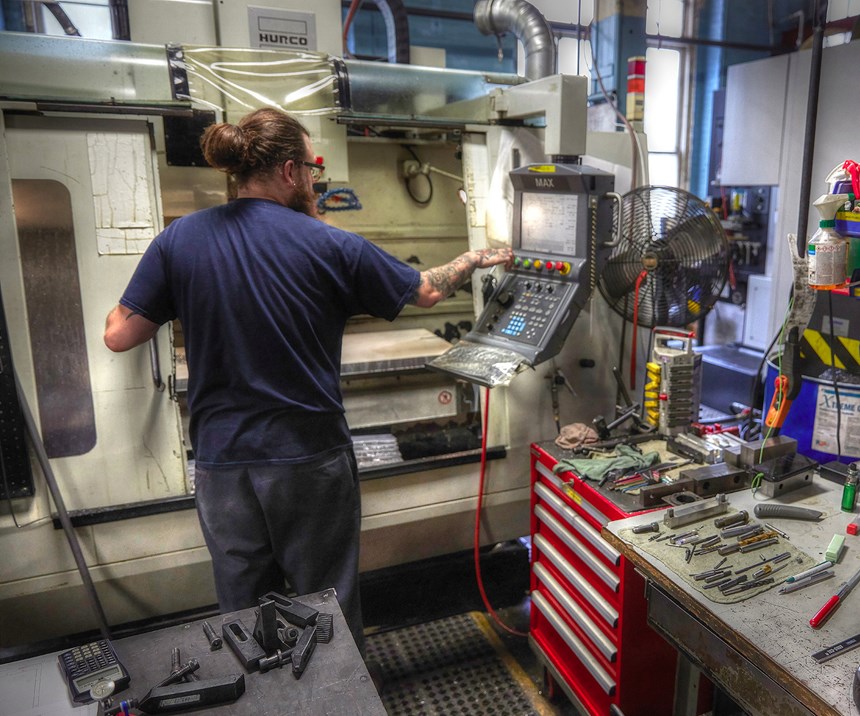Machine Shop Finds Opportunities with SLA 3D Printer
Adding a Form 2 desktop stereolithography 3D printer from Formlabs has enabled A&M Tool and Design to expedite workflows with 3D-printed prototypes, tooling and more.
Share





While speed is often linked to production-environment success, adding new tools to increase efficiency can also present challenges. Mainly, the ever-changing technology landscape does not make it easy for manufacturers and machine shops to choose technology that is both reliable and cost-effective. With these requirements in mind, A&M Tool and Design recently added a polymer 3D printer to its toolset. Offering a precise, fast means of making prototypes and other parts, this 3D printer has helped expedite workflows and increase the shop’s capacity for affordably producing parts in house.
Toward Efficiency and Precision
Established in 1948, A&M Tool and Design started as a family-owned, single-source precision machine shop in Southbridge, Massachusetts. Today, alongside highly skilled operators running classic Bridgeport CNC mills stand eight-sided tombstones for a Mazak Palletech system that can run unattended 24/7.
The shop has modernized over the years to introduce a range of new equipment in addition to reliable traditional technology and retrofitted solutions to produce parts and custom machines for aerospace, optics and robotics. Customers include Boston Dynamics, LinkNYC, NASA, Goodrich and Corning.
In addition to its large-scale manufacturing automation equipment like the Palletech, the shop added an industrial-grade desktop stereolithography (SLA) 3D printer last year to expedite projects and open capacity to supplement an understaffed engineering team. In order to effectively replace prototyping that would otherwise be done through more labor-intensive processes or workflows, the 3D printer had to be both cost-effective and precise. Ryan Little, an A&M mechanical engineer, researched which 3D printer would be the best match for the company’s needs, and selected the Form 2 desktop 3D printer from Formlabs.
“Part of our pursuit in looking for a 3D printer was being able to have something that could run pretty autonomously with limited training,” Mr. Little says. “We can run some of the CNC machines downstairs, but they're rarely available, and programming a CNC machine for an advanced job in Mastercam, or just trying to do it on the controller itself, can take hours. Starting up a job with Formlabs PreForm software takes 10 minutes, and it's really simple.”
The company has since scaled 3D-printing applications from prototyping and communications models to quick-turn production tools and end-use parts for custom machinery.
“3D printing has become a priceless tool in our toolbox,” says Guido Jacques, vice president of operations at A&M. “It’s kind of a cliché, but it’s really allowing all of us to think completely outside the box.”
3D Printing Opportunities
Mr. Little and his team are constantly finding opportunities to leverage cost-effective 3D-printed plastic parts to enhance workflows and projects. The shop has come to rely on the printer to mitigate errors and accelerate timelines from pre-production prototyping, to creating production tools to printing end-use parts for quick fixes.
In many cases, it is a materials-led decision: Does this part need to be metal? Can a polymer-based material be an easy substitute?
“There are plenty of things that our engineers can go turn on a lathe,” Mr. Little says. “We can whip out a very specific diameter shaft in 20 minutes, and it'll be very accurate. But if it's something that it would take a machinist five hours to program and 10 hours to make, we can choose 3D printing over machining. It's very similar to the machining world, where you could probably make this out of aluminum. It doesn't need to be titanium.”
Accelerating Prototyping
For prototyping, the shop started using 3D prints to test fit and function. 3D printing enables the engineering team to make parts much faster and utilize all hours of the day, setting up prints to run overnight, then using parts the next day. Printing is especially helpful for geometries that are costly and time consuming to produce on a CNC machine.
“The printer almost feels like an auxiliary tool in addition to CAD,” Mr. Little says. “We do a ton of prototyping for different types of tooling. If we didn’t have the Form 2, many prototypes would just stay in CAD until we were ready to machine, and there would be some things that would never get made or designed because it wouldn't be practical.”
Improving Communication
The A&M engineering team also uses 3D prints to help communicate with machinists and welders, turning complex drawings into physical models. Increasingly, the machinists themselves are making requests for models.
“Sometimes we'll see a finished part and realize a hole was tapped in the wrong direction, or a feature wasn't supposed to be on a certain side–and that's not something you can fix. When that happens, the part is pretty much finished, and you have to restart,” Mr. Little says.
“We have talented machinists here who can interpret drawings with so many call-outs on them that you almost can't see what's happening, but even still, machinists will have to ask for clarity, especially when there are more complex geometries like undercuts. Now, if we have an assembly or SolidWorks file, we'll make a scale model of the part and give it to them, and they love that. The whole shop is actually starting to draw on it.”
In-House Jigs and Fixtures, 3D-Printed End-Use Parts
Beyond prototyping, the A&M team has scaled to use 3D printing to produce functional parts like fixtures and even several end-use parts, from an ergonomic knob for a custom-built machine to a coupling used for a short-term fix for one of its large lens polishing machines.
For example, when a spider coupling for the lens polishing machine arrived in the wrong size two days before a big trade show, Mr. Little quickly designed and 3D printed a correctly sized replacement in Formlabs’ Durable Resin. The printed coupling was used to drive a 2-horsepower motor on a grinding machine.
Ongoing Applications for 3D Printing
Since the introduction of its 3D printer less than a year ago, A&M has continued to find valuable new applications and experiment with new materials.
“3D printing allows us to do a lot of things that the shop can't easily do—geometries for making parts that would be a nightmare on a machine, etc.,” Mr. Little says. “It's given the shop a real advantage.” Mr. Jacques adds that it has justified itself by enabling the shop to do things its customers were not even thinking about at the time of purchase.
About the Author
Andrew Edman
Andrew Edman is an applications engineer at Formlabs focused on using additive technologies to create value in manufacturing and industrial workflows, like using 3D-printed tooling to bridge from prototype to production.
Prior to Formlabs, Mr. Edman ran a design and engineering consultancy, helping startups and Fortune 500 companies develop products from concept through to scale manufacturing.
Related Content
JTEKT Technology Days Showcases Synergies
The event took place following the company’s completion of its new showroom and decision to merge several of its brands under the JTEKT name.
Read MoreThe Cool Parts Showcase Seeks Innovative 3D Printed Parts
Do you solve problems with 3D printing? Enter your 3D printed parts in this contest from The Cool Parts Show.
Read MoreIn Moldmaking, Mantle Process Addresses Lead Time and Talent Pool
A new process delivered through what looks like a standard machining center promises to streamline machining of injection mold cores and cavities and even answer the declining availability of toolmakers.
Read MoreDigitalization and Done-In-One Reign Supreme at BIEMH 2024
European manufacturers may have a different balance of markets than their U.S. counterparts, but the practical challenges they must overcome are often similar — as are the solutions.
Read MoreRead Next
Setting Up the Building Blocks for a Digital Factory
Woodward Inc. spent over a year developing an API to connect machines to its digital factory. Caron Engineering’s MiConnect has cut most of this process while also granting the shop greater access to machine information.
Read MoreBuilding Out a Foundation for Student Machinists
Autodesk and Haas have teamed up to produce an introductory course for students that covers the basics of CAD, CAM and CNC while providing them with a portfolio part.
Read MoreRegistration Now Open for the Precision Machining Technology Show (PMTS) 2025
The precision machining industry’s premier event returns to Cleveland, OH, April 1-3.
Read More























.jpg;maxWidth=300;quality=90)










